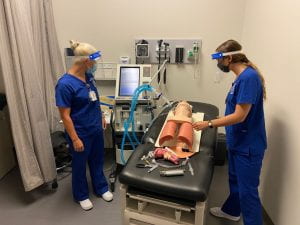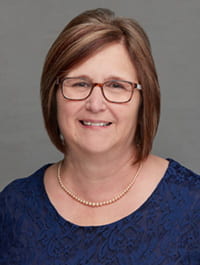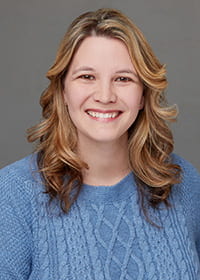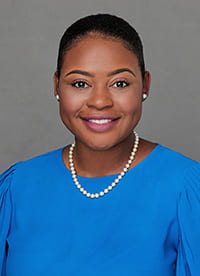
Students in the Nursing of the Childbearing Family course are working through new simulation Dr. Linda Billings, clinical associate professor, developed with our new OB simulator, Victoria. The primary instructors are Billings and Professor Melissa Shoaff.
During the pandemic, technology plays a larger role in the education of nursing students at the Loewenberg College of Nursing. Because access to clinical settings were suspended and/or limited, faculty teaching had a unique opportunity to integrate technology of virtual simulation to educate students about clinical reasoning and judgment.
For her Childbearing Family Nursing course, Dr. Linda Billings incorporated a new manikin that can deliver a baby, facilitating students to not only practice delivering a baby but take care of an antepartum and postpartum patient as well. During simulation, students are given scenarios they use to assess mother and baby.
Dr. Billings said the well-designed simulation helped prepare students to care for live patients. “Students provided positive feedback for the simulated clinical learning experience. They said that even though it prepares them to care for patients in the hospital, they wished they could care for a live patient more.”
The fall semester in 2020, the University of Memphis began virtual instruction except for courses or instruction that needed to be held on ground. Those courses were to abide by scientific based safety guidelines to help protect students, faculty and staff from the spread of coronavirus. Amid COVID, some practice settings limit numbers of nursing students. Again, integration of simulations in clinical teaching enables students to learn core knowledge and skills from comprehension to application.
“We were not sure all the students would get to go to the hospital throughout the entire semester, so we rotated them. This way all students had an experience with a delivery and caring for the post-partum woman, whether it was at the hospital or in simulation. Some students at the hospital did not get to see a delivery. The simulation gives them that opportunity.”
Planning for spring 2021, Dr. Billings would like to further integrate the technology into her course. She will combine on site clinical practicum with designed simulated clinical to continue cultivating students critical thinking, clinical reasoning, and clinical judgment.
“The vSims would be great to use when students could not be on ground for their clinical practicum at the request of the clinical site,” said Dr. Billings about the new program acquired by Simulation Director Nathan Knappier. It uses an internet-based interactive platform to deliver clinical instruction to students.
Clinical Assistant Professor Janye Wilson incorporated vSim into her gerontology practicum course to replace on-site patient simulations she conducted with actors. With vSim, she used the same patient scenarios but was able to expand them and was able to include patient progression for diseases and conditions.
“vSim works very well with the gerontology practicum course… vSim facilitates students to practice the scenarios for accuracy and grades their performance, learning from their mistakes, if any. Each scenario has a pre- and post-quiz for students that faculty can access.”
Wilson used Zoom to debrief students, using questions provided in vSim to help the students use what they learned and think about how they cared for patients in the real world.” Wilson continued, “Student and faculty feedback have been very positive for vSim. I would like to continue using it, especially since we do not know when we will be able to fully return to the long-term care facilities.”
In teaching mental health, Dr. Y’Esha Williams has used a variety of simulated methods to provide her students essential knowledge they needed because mental health clinical sites have not opened to students.
“vSim provided the students the opportunity to go online each week and assess, diagnose, intervene, provide outcomes and learn about medications,” she said.
Mental health nursing students also used a free, online simulation resource created by Ryerson University called the Therapeutic Communication and Mental Health Assessment. This program provides students with an opportunity to conduct a mental health assessment with a simulated patient and apply it to crisis intervention. Students learned and were evaluated by their demonstration of knowledge related to therapeutic communication and application of the knowledge for crisis intervention. Through Zoom, students watch a de-escalation video that helps students understand positive ways to de-escalate potentially dangerous patient situations.

Students in the Nursing of the Adult II skills lab getting basic ventilator and inline suctioning training. The professors are Kay Sims and Kaye Litano.
Dr. Williams also used on-ground simulation in small-groups in adherence to established safety measures such as social distancing and mask wearing. To give students an idea of what patients with auditory hallucinations experience, she conducted an on-site simulation where students were asked to wear headphones that allowed them to hear voices while they were being asked to perform ordinary tasks. Students were able to discuss the level of difficulty with the task and how a patient that has this experience might feel.
Although simulation is valuable, it is missing the interprofessional experience that students gain from being around mental health and other professionals, in addition to the experience of understanding safety in that setting.
Dr. Williams said, “I am happy with LCON’s ability to adapt so quickly to the changing environment. Literally in a week’s time, we were able to find a suitable simulation program to use across the college to ensure students are still learning.”









